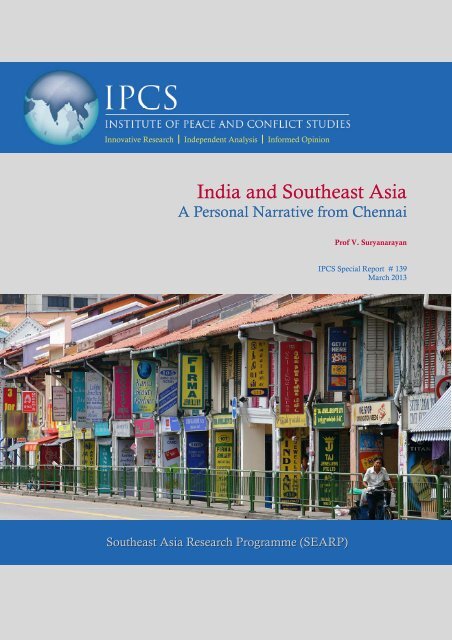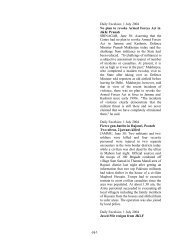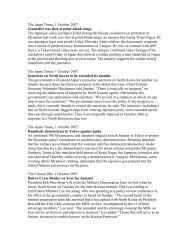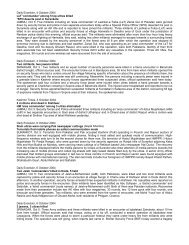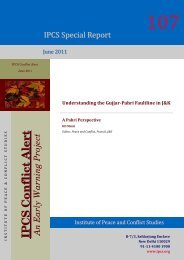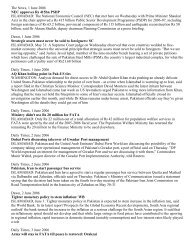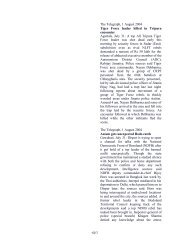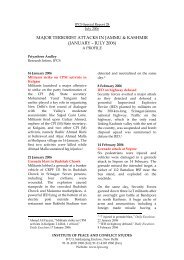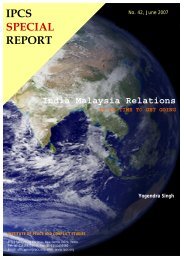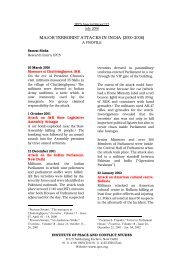India and Southeast Asia: A Personal Narrative from Chennai
India and Southeast Asia: A Personal Narrative from Chennai
India and Southeast Asia: A Personal Narrative from Chennai
You also want an ePaper? Increase the reach of your titles
YUMPU automatically turns print PDFs into web optimized ePapers that Google loves.
Innovative Research | Independent Analysis | Informed Opinion<br />
<strong>India</strong> <strong>and</strong> <strong>Southeast</strong> <strong>Asia</strong><br />
A <strong>Personal</strong> <strong>Narrative</strong> <strong>from</strong> <strong>Chennai</strong><br />
Prof V. Suryanarayan<br />
IPCS Special Report # 139<br />
March 2013<br />
<strong>Southeast</strong> <strong>Asia</strong> Research Programme (SEARP)
INDIA AND SOUTHEAST ASIA<br />
About the Institute<br />
The Institute of Peace<br />
<strong>and</strong> Conflict Studies<br />
(IPCS), established in<br />
August 1996, is an<br />
independent think tank<br />
devoted to research on<br />
peace <strong>and</strong> security <strong>from</strong> a<br />
South <strong>Asia</strong>n perspective.<br />
Its aim is to develop a<br />
comprehensive <strong>and</strong><br />
alternative framework for<br />
peace <strong>and</strong> security in the<br />
region catering to the<br />
changing dem<strong>and</strong>s of<br />
national, regional <strong>and</strong><br />
global security.<br />
Copyright @ IPCS, 2013<br />
Cover Photo : Little <strong>India</strong> in<br />
Singapore<br />
B 7/3 Lower Ground Floor,<br />
Safdarjung Enclave, New<br />
Delhi 110029, INDIA.<br />
Tel: 91-11-4100 1900, 4165<br />
2556, 4165 2557, 4165 2558,<br />
4165 2559 Fax: (91-11)<br />
41652560<br />
Email:<br />
About the Author<br />
Dr. V. Suryanarayan is Senior Professor <strong>and</strong><br />
Director (Retd), Centre for South <strong>and</strong> <strong>Southeast</strong><br />
<strong>Asia</strong>n Studies, University of Madras. Since his<br />
retirement, he is actively associated with two leading<br />
think tanks in <strong>Chennai</strong>, the Center for <strong>Asia</strong> Studies<br />
<strong>and</strong> the <strong>Chennai</strong> Centre for China Studies.<br />
Prof. Suryanarayan was also a member of the<br />
National Security Advisory Board of the<br />
Government of <strong>India</strong> for one term.<br />
Contents<br />
South <strong>and</strong> <strong>Southeast</strong> <strong>Asia</strong>: The Artificial<br />
Division<br />
How to measure success of Foreign Policy?<br />
Northeast <strong>India</strong>: Bridgehead to <strong>Southeast</strong> <strong>Asia</strong><br />
Stateless People of <strong>India</strong>n Origin in Malaysia <strong>and</strong><br />
Myanmar<br />
China’s growing influence in <strong>Southeast</strong> <strong>Asia</strong><br />
Emerging Situation: A Response <strong>from</strong> <strong>India</strong><br />
04<br />
07<br />
08<br />
10<br />
11<br />
12
IPCS SPECIAL REPORT #139, MARCH 2013<br />
<strong>India</strong> <strong>and</strong> <strong>Southeast</strong> <strong>Asia</strong><br />
A <strong>Personal</strong> <strong>Narrative</strong> <strong>from</strong> <strong>Chennai</strong><br />
Prof V Suryanarayan<br />
Former Director, Centre for South <strong>and</strong> <strong>Southeast</strong> <strong>Asia</strong>n Studies, University of<br />
Madras<br />
Let me begin the essay by stating the obvious. <strong>India</strong> has l<strong>and</strong> boundaries with Pakistan,<br />
China, Nepal, Bhutan, Bangladesh <strong>and</strong> Myanmar <strong>and</strong> maritime borders with Pakistan,<br />
Bangladesh, Myanmar, Thail<strong>and</strong>, Indonesia, Sri Lanka <strong>and</strong> Maldives. The twists <strong>and</strong><br />
turns in <strong>India</strong>’s relations with neighbouring countries will have their immediate fallout<br />
on contiguous <strong>India</strong>n states. If one takes an overview of <strong>India</strong>’s neighbourhood policy<br />
since independence, on several occasions, New Delhi, with the objective of<br />
strengthening bilateral relations, have sacrificed the interests of the contiguous <strong>India</strong>n<br />
states.<br />
Let me give two illustrations for this. The Sirimavo-Shastri Pact, 1964, which converted<br />
the people of <strong>India</strong>n origin in Sri Lanka into merch<strong>and</strong>ise to be divided between the<br />
two countries in the name of good neighbourly relations, was concluded without taking<br />
into consideration the views of the affected people. It was signed despite strong<br />
opposition <strong>from</strong> important political leaders like Kamaraj Nadar, VK Krishna Menon,<br />
CN Annadurai <strong>and</strong> P Ramamurthy. It was also a betrayal of G<strong>and</strong>hi-Nehru legacy on<br />
<strong>India</strong>ns Overseas. Second, the conclusion of the <strong>India</strong>-Sri Lanka Maritime Boundary<br />
Agreements of 1974 <strong>and</strong> 1976, which ceded the isl<strong>and</strong> of Kachchatheevu to Sri Lanka<br />
<strong>and</strong> bartered away the traditional fishing rights enjoyed by the <strong>India</strong>n fishermen, was<br />
preceded by strong opposition <strong>from</strong> various political parties in Tamil Nadu.<br />
It is my submission that in formulating <strong>India</strong>’s neighbourhood policy the <strong>India</strong>n<br />
Foreign Office should take into consideration the feelings <strong>and</strong> sentimentsof contiguous<br />
<strong>India</strong>n States. What is good for New Delhi should also be good for <strong>Chennai</strong>. In other<br />
words, opportunities must be provided for the State of Tamil Nadu to make benign<br />
inputs into the making of <strong>India</strong>’s neighbourhood policy. May I underline this point by<br />
giving an illustration <strong>from</strong> <strong>India</strong>-Myanmar relations <strong>and</strong> how the attempts by made by<br />
former Chief Minister CN Annadurai did not elicit any favourable response <strong>from</strong> New<br />
Delhi.<br />
The Government of Burma in the 1950’s introduced the Burmanisation of public<br />
services; large number of <strong>India</strong>ns employed in the railways, water transport, customs,<br />
post <strong>and</strong> telegraph, public works <strong>and</strong> other departments were retrenched. In the 1960’s<br />
under the Burmese Socialist Programme, the Government even nationalized retail<br />
trade. These measures sounded the death knell of the poorer sections of the <strong>India</strong>n<br />
Tamil community. To add insult to injury, they were not even permitted to bring back<br />
their savings to <strong>India</strong>. Women were not even permitted to take back their<br />
Mangalyasutra. The repatriates also complained about demonetization of currency<br />
notes, expropriation of properties, confiscation of valuables <strong>and</strong> unimaginable<br />
humiliations. According to the Policy Note issued by the Government of Tamil Nadu,<br />
<strong>from</strong> June 1963 onwards, 1, 44,353 Burmese repatriates returned to <strong>India</strong>. What is<br />
Even a transformed<br />
Myanmar is still miles<br />
away <strong>from</strong> durable peace.<br />
Notwithst<strong>and</strong>ing<br />
numerous ceasefire<br />
agreements the<br />
government has signed<br />
with the ethnic armed<br />
insurgencies, peace<br />
remains tenuous<br />
03
INDIA AND SOUTHEAST ASIA<br />
more tragic, even after the lapse of five decades, the compensation due to these people<br />
have not been settled.<br />
The isl<strong>and</strong> of Pu Breush,<br />
located in northwest of<br />
Sumatra, is only 92 nautical<br />
miles <strong>from</strong> Indira Point,<br />
which is less than the distance<br />
between <strong>Chennai</strong> <strong>and</strong><br />
Tirupati. Similarly Phuket in<br />
Thail<strong>and</strong> is only 273 nautical<br />
miles away <strong>from</strong> Indira Point,<br />
which is less than the distance<br />
between <strong>Chennai</strong> <strong>and</strong><br />
Madurai<br />
C.N. Annadurai, who became the Chief Minister of Tamil Nadu, when the DMK was<br />
voted to power in the 1967 general elections, was very concerned about the<br />
developments in Burma. He was keen to resolve the issue of compensation<br />
expeditiously. In a conversation me, Thomas Abraham, the then Minister Counselor<br />
in the <strong>India</strong>n Embassy in Rangoon, recalled his meeting with Annadurai in the Chief<br />
Minister’s residence in Mambalam. The meeting was arranged through the good offices<br />
of common friends. After discussing the pros <strong>and</strong> cons of the matter, Annadurai wrote<br />
a letter to the Central Government suggesting that <strong>India</strong> should enter into a long term<br />
agreement with Burma for the import of rice <strong>and</strong> the compensation due to the<br />
repatriates should be adjusted in the proposed deal. It may be recalled that during 1967<br />
<strong>India</strong> was facing an acute crisis in food grains. On his return to Rangoon, Thomas<br />
Abraham also made a similar proposal to the Ministry of External Affairs. It is<br />
unfortunate, but true, that these concrete proposals did not elicit any favourable<br />
response <strong>from</strong> New Delhi. (1).<br />
I<br />
SOUTH ASIA AND SOUTHEAST ASIA: THE ARTIFICIAL DIVISION<br />
It is necessary to remind ourselves that the concept of “Area” - South <strong>Asia</strong>, <strong>Southeast</strong><br />
<strong>Asia</strong>, East <strong>Asia</strong>, West <strong>Asia</strong> <strong>and</strong> Central <strong>Asia</strong> – which gained currency after the Second<br />
World War was an offshoot of our intellectual dependence on Western scholarship. In<br />
fact, the cold war <strong>and</strong> the legacies of the colonial rule have done incalculable harm to<br />
<strong>India</strong>n scholarship <strong>and</strong> thought processes.<br />
To illustrate this , despite our maritime heritage, few people in <strong>India</strong> are conscious of<br />
the fact that the isl<strong>and</strong> of Pu Breush, located in northwest of Sumatra, is only 92<br />
nautical miles <strong>from</strong> Indira Point, which is less than the distance between <strong>Chennai</strong> <strong>and</strong><br />
Tirupati. Similarly Phuket in Thail<strong>and</strong> is only 273 nautical miles away <strong>from</strong> Indira<br />
Point, which is less than the distance between <strong>Chennai</strong> <strong>and</strong> Madurai. Since most of the<br />
leaders in north <strong>India</strong> are sea blind, Indonesia <strong>and</strong> Thail<strong>and</strong>, in New Delhi’s<br />
perception, became distant neighbours, because they were part of a different area. The<br />
Ministry of External Affairs, every year brings out an annual report. In the report, there<br />
are two chapters entitled immediate neighbours <strong>and</strong> emerging neighbourhood.<br />
Thail<strong>and</strong> <strong>and</strong> Indonesia falls into the second category. How much more near should<br />
Thail<strong>and</strong> <strong>and</strong> Indonesia be to <strong>India</strong> for the M<strong>and</strong>arins in South Block to realize that<br />
Thail<strong>and</strong> <strong>and</strong> Indonesia are our immediate neighbours <strong>and</strong> not emerging neighbours.<br />
It is high time that we in <strong>Asia</strong> redefine the concept of “area” taking into consideration<br />
both historical <strong>and</strong> geo-political realities. The concept of ocean as a unifying force <strong>and</strong><br />
as an instrument of regional co-operation has not been fully grasped. Taking these<br />
points into consideration, since the early 1990’s, I, along with Prof. KR Singh of<br />
Jawaharlal Nehru University, have been advocating the formation of a “Bay of Bengal<br />
Community”. In a wider sense, the Bay of Bengal should also include the Andaman<br />
Sea <strong>and</strong> the Malacca Strait, which are only adjuncts of the Bay of Bengal. The<br />
underlying idea is not to replace SAARC or ASEAN but to have an additional<br />
organization, which will bring together <strong>India</strong> <strong>and</strong> its maritime neighbours in its<br />
southern <strong>and</strong> eastern sides. What should make the Bay of Bengal Community an<br />
attractive proposition is the fact that unlike South China Sea, where conflicting<br />
territorial claims threaten peace <strong>and</strong> stability, the Bay of Bengal region is relatively an<br />
04
IPCS SPECIAL REPORT #139, MARCH 2013<br />
area of peace <strong>and</strong> tranquility. What is more, <strong>India</strong>’s two difficult neighbours, Pakistan<br />
<strong>and</strong> China, are not part of the Bay of Bengal Community.<br />
Despite obvious advantages, the idea did not elicit any favourable response <strong>from</strong> the<br />
<strong>India</strong>n Foreign Office for a long time. In a conversation with the author, Amb Ranjit<br />
Gupta, former <strong>India</strong>n Ambassador to Thail<strong>and</strong>, recalled that when he broached the<br />
subject to Amb JN Dixit, then Foreign Secretary, he ridiculed the whole concept as<br />
preposterous. Amb Ranjit Gupta did not give up; he was able to win over the Thai<br />
Foreign Minister to his side. It is well known that the idea of BIMSTEC was officially<br />
suggested by the Thai Foreign Office. It was a good mechanism to combine the “Look<br />
West” policy of Thail<strong>and</strong> with the “Look East” policy of <strong>India</strong>. New Delhi had to fall in<br />
line <strong>and</strong> in June 1988 BIMSTEC (Bangladesh, <strong>India</strong>, Myanmar, Sri Lanka <strong>and</strong><br />
Thail<strong>and</strong> Economic Co-operation) was born. The membership was exp<strong>and</strong>ed in 2004 to<br />
include the two l<strong>and</strong> locked states of Nepal <strong>and</strong> Bhutan. It was also resolved to change<br />
the name of the organization to Bay of Bengal Initiative for Multi-Sectoral Technical<br />
<strong>and</strong> Economic Co-operation. Several priority sectors were identified, but the progress of<br />
BIMSTEC had been very slow.<br />
If BIMSTEC has to attain its lofty objectives, the member states, in letter <strong>and</strong> spirit,<br />
must follow what the Javanese call the principle of Gotong Royong (Mutual Cooperation).<br />
Today regional co-operation occupies a very low priority in our foreign<br />
policy; it must become central to our foreign policy objectives. And when we finalise<br />
our five year plans, a chapter should be included spelling out the details of economic<br />
diplomacy <strong>and</strong> how it will give a fillip to regional co-operation. Then only we will be<br />
able to infuse flesh <strong>and</strong> blood into the concept of regional co-operation (2).<br />
As far as civilizational states like <strong>India</strong> <strong>and</strong> China are concerned, no epoch in history is<br />
complete in itself; it is both a continuation <strong>and</strong> a beginning. Former Prime Minister<br />
Narasimha Rao underlined this basic reality in his famous speech <strong>India</strong> <strong>and</strong> the <strong>Asia</strong>-<br />
Pacific: Forging a New Relationship in October 1994 at the Institute of <strong>Southeast</strong> <strong>Asia</strong>n<br />
Studies in Singapore. The closer relationship which <strong>India</strong> seeks today with <strong>Southeast</strong><br />
<strong>Asia</strong>n countries, as Prime Minister Narasimha Rao underlined, has to be fashioned on<br />
twin foundations – the benign interaction of the past <strong>and</strong> mutuality of interests that<br />
exist at present (3).<br />
In its relations with <strong>Southeast</strong> <strong>Asia</strong>n countries, <strong>India</strong> has several plus points.<br />
Historically Burma, Thail<strong>and</strong>, Cambodia, Laos, South Vietnam, Malaysia <strong>and</strong><br />
Indonesia have been deeply influenced by <strong>India</strong>n political ideas, religion, art <strong>and</strong><br />
language. The spread of cultural influences, leading to the cultural enrichment of<br />
<strong>Southeast</strong> <strong>Asia</strong>n countries, constitutes a glorious chapter in <strong>India</strong>n <strong>and</strong> <strong>Southeast</strong> <strong>Asia</strong>n<br />
history alike. <strong>India</strong>nised kingdoms like Funan, Sri Kshetra, Pagan, Khemer, Sri Vijaya,<br />
Sailendra <strong>and</strong> Majapahit; the familiar Indo-Sanskritic vocabulary in Thai <strong>and</strong> Bahasa<br />
Indonesia; architectural monuments like Angkor Wat, Pagan, Borobudur <strong>and</strong> Lara<br />
Djonggrong; literary masterpieces like Ramkien, Amaramala, Arjuna Vivaha <strong>and</strong><br />
Bharata Yuddha; the Wajang Kulit based on the Ramayana <strong>and</strong> Mahabharata themes;<br />
the living <strong>India</strong>n traditions in the isl<strong>and</strong> of Bali – all these bear testimony to the<br />
courage <strong>and</strong> zeal of <strong>India</strong>n princes, priests, poets, merchants <strong>and</strong> artisans <strong>and</strong> the<br />
ingratiating <strong>and</strong> assimilable qualities of the <strong>Southeast</strong> <strong>Asia</strong>n peoples.<br />
Historically Burma,<br />
Thail<strong>and</strong>, Cambodia, Laos,<br />
South Vietnam, Malaysia<br />
<strong>and</strong> Indonesia have been<br />
deeply influenced by <strong>India</strong>n<br />
political ideas, religion, art<br />
<strong>and</strong> language. The spread of<br />
cultural influences, leading to<br />
the cultural enrichment of<br />
<strong>Southeast</strong> <strong>Asia</strong>n countries,<br />
constitutes a glorious chapter<br />
in <strong>India</strong>n <strong>and</strong> <strong>Southeast</strong><br />
<strong>Asia</strong>n history alike.<br />
Not much work has been done by <strong>India</strong>n scholars on the impact of culture in <strong>India</strong>n<br />
foreign policy. In fact, as far as <strong>Southeast</strong> <strong>Asia</strong> is concerned, the fascinating encounter<br />
among Indigenous, <strong>India</strong>n <strong>and</strong> Chinese influences deserves deeper study <strong>and</strong> sharper<br />
focus. Equally relevant <strong>India</strong> has not been able to exploit to the full the advantages that<br />
05
INDIA AND SOUTHEAST ASIA<br />
we have in the field of higher education. Few years ago, I visited the University of<br />
Manipur to hold a PhD viva voce examination. I was surprised to find a Naga student<br />
who had come <strong>from</strong> Myanmar for higher studies. In my naiveté, I asked him, “Was it<br />
difficult for you to get a student visa <strong>from</strong> the <strong>India</strong>n Embassy in Rangoon?” The<br />
student began to laugh. When I asked him why he was laughing, he said, “I just cross<br />
the mountains <strong>and</strong> come to Imphal. During vacation I cross the mountains <strong>and</strong> return<br />
home”. The Universities in Northeast <strong>India</strong> are relatively more developed than the<br />
educational institutions in the Burmese side. The government of <strong>India</strong> should<br />
immediately liberalise the admission procedures, institute more scholarships <strong>and</strong><br />
delegate the power of issuing student visa to these Universities so that we could attract<br />
more students <strong>from</strong> the Burmese side.<br />
The delay between assurances <strong>and</strong> implementation was mentioned to me by Amb AN<br />
Ram, who was <strong>India</strong>n Ambassador to Thail<strong>and</strong> when the Look East policy gained<br />
momentum. Prime Minister Narasimha Rao visited Thail<strong>and</strong> <strong>and</strong> addressed the faculty<br />
<strong>and</strong> students of Thamassaat University. Sensitive to the potentials of cultural<br />
diplomacy, Narasimha Rao announced that Thai Buddhist pilgrims visiting <strong>India</strong><br />
would be exempted <strong>from</strong> paying visa fees. The announcement was heartily welcomed<br />
by all sections of Thai people. However, it took many years before bureaucratic hurdles<br />
could be overcome <strong>and</strong> the proposal got implemented. The same delay occurred in the<br />
starting of air services between Bangkok <strong>and</strong> Buddhist places of pilgrimage in <strong>India</strong> like<br />
Varanasi <strong>and</strong> Bodh Gaya.<br />
Lessons <strong>from</strong> <strong>Southeast</strong> <strong>Asia</strong>n History<br />
<strong>Southeast</strong> <strong>Asia</strong> had always been subjected to external influences. But in the early phase<br />
of its history, it was the <strong>India</strong>n influences that were more dominant. While <strong>Southeast</strong><br />
<strong>Asia</strong> traded extensively with China <strong>and</strong> the Far East, it was <strong>from</strong> <strong>India</strong> that much of<br />
<strong>Southeast</strong> <strong>Asia</strong>n religion, philosophy <strong>and</strong> aesthetics were drawn. As the Malaysian<br />
scholar Farish A Noor has written, “The development of <strong>Southeast</strong> <strong>Asia</strong>n civilization<br />
went h<strong>and</strong> in h<strong>and</strong> with that of the <strong>India</strong>n sub-continent” (4). As the <strong>India</strong>n influences<br />
began to be felt the local people adapted them “to the lay of the l<strong>and</strong> <strong>and</strong> the needs of<br />
the time”. <strong>India</strong>nisation was never “a straightforward <strong>and</strong> direct process, but rather a<br />
selective endeavour where the agency <strong>and</strong> selectivity of the recipient communities were<br />
evident” (5).<br />
In the pre-modern period of <strong>Southeast</strong> <strong>Asia</strong>n history, there were no boundaries <strong>and</strong><br />
political frontiers <strong>and</strong>, therefore, no sense of political loyalty to the state. Moreover,<br />
communities like the Malays, Minangs, Javanese, Cantonese, Arabs, Tamils <strong>and</strong><br />
Eurasian Peranakans have existed long before the advent of colonialists. There were<br />
differences in language, culture, arts as well as social customs among these groups, but,<br />
at the same time, there was cultural overlapping, cross-cultural fertilization <strong>and</strong> cultural<br />
hybridization. With the advent of the colonial rule, ethnicity got entrenched. As Prof.<br />
Charles Hirshmann has pointed out , “More than rubber <strong>and</strong> tin, the legacy of<br />
colonialism in Malaya was the racial ideology” (6). Stereotypes developed <strong>and</strong> they were<br />
perpetuated by political ideologues; as far as Malaya <strong>and</strong> Singapore were concerned, it<br />
was maintained by the British that the Malay is an idler, the Chinaman is a thief <strong>and</strong><br />
the <strong>India</strong>n is a drunkard. Yet each, in his special class of work is both cheap <strong>and</strong><br />
efficient, when properly supervised (7)<br />
06
IPCS SPECIAL REPORT #139, MARCH 2013<br />
II<br />
HOW TO MEASURE THE SUCCESS OF FOREIGN POLICY?<br />
It is appropriate to pose the question: How do we measure the success of <strong>India</strong>n foreign<br />
policy? One yardstick is to anticipate the turn of events <strong>and</strong> adjust the foreign policy<br />
accordingly. Given below are two examples, one of great success <strong>and</strong> the other a colossal<br />
failure. In the early years of independence, when the Western countries were viewing<br />
the communist world as a monolith, Nehru was deeply sensitive to the changes that<br />
were taking place within the communist world. Nehru told President Eisenhower that<br />
the United States should not be obsessed with communism as an ideology because it<br />
contained within itself the seeds of its own destruction. Nehru was conscious of the<br />
widening Sino-Soviet differences <strong>and</strong> how they could have benign fallout for <strong>India</strong>.<br />
In his book, New Dimensions of Peace, Amb Chester Bowles has mentioned that<br />
Nehru told him in early 1950’s that Sino-Soviet entente was unlikely to last long. In<br />
September 1959, in a speech in Parliament, Nehru referred to a statement in TASS <strong>and</strong><br />
how it indicated that the Soviet Union was taking a calm <strong>and</strong> dispassionate view of the<br />
border situation. The TASS statement, as is well known, was the first indication of<br />
Sino-Soviet differences being aired in the open. Nehru knew of the heated exchanges<br />
that took place between Khrushchev <strong>and</strong> Chen Yi in Bucharest, he knew of the Chinese<br />
anger at the Soviet Union selling MIG planes to <strong>India</strong>, the withdrawal of Soviet<br />
technicians <strong>from</strong> China <strong>and</strong> the skirmishes in the Sino-Soviet border in 1960. Nehru<br />
dissociated China’s expansionist policy <strong>from</strong> communist ideology. Such a stance<br />
enabled <strong>India</strong> to take advantage of the Sino-Soviet dispute <strong>and</strong> get considerable support<br />
<strong>from</strong> Soviet Union in the years to come (8).<br />
The failure to correctly fathom the emerging trends was with reference to China.<br />
Jawaharlal Nehru never subscribed to the view that China would resort to the use of<br />
force to buttress its territorial claims <strong>and</strong> when the Chinese invasion took place he<br />
frankly admitted in Parliament that we were living in an “artificial world of our own<br />
creation”. Furthermore ,on several occasions, New Delhi worked on the assumption<br />
that what it wants may come true. In August 1991, there was news of an attempted<br />
coup against Gorbachev. The group opposed to Gorbachev claimed that it had captured<br />
power. Within three days Yeltsin crushed the coup. Unfortunately in the <strong>India</strong>n<br />
Embassy’s assessment the coup was a success <strong>and</strong> the matter was reported to New Delhi.<br />
What is more tragic is that , the <strong>India</strong>n Prime Minister made an announcement<br />
welcoming the coup just before it was crushed. Today Unfortunately <strong>India</strong>’s foreign<br />
policy has become reactive to international developments (9).<br />
What is more regrettable is the fact that on crucial occasions New Delhi failed to st<strong>and</strong><br />
by its cherished principles of foreign policy. <strong>India</strong>’s Indo-China policy after 1978 was<br />
based on its underst<strong>and</strong>ing of the emerging Sino-Vietnamese dispute, the increasing<br />
Sino-Soviet rivalry <strong>and</strong> the unfortunate policy of ostracizing Vietnam by ASEAN, with<br />
the backing of the United States <strong>and</strong> China. Though there were convergence of<br />
interests among New Delhi, Kuala Lumpur <strong>and</strong> Jakarta that it was China, not Vietnam,<br />
which posed the long term threat to the stability <strong>and</strong> security of <strong>Southeast</strong> <strong>Asia</strong>.<br />
On several occasions, the <strong>India</strong>n diplomats adopted a defensive attitude. The decision<br />
in the last moment not to participate as a dialogue partner in the ASEAN Foreign<br />
Ministers meeting in Kuala Lumpur in June 1990 did in no way enhance the prestige<br />
<strong>and</strong> st<strong>and</strong>ing of <strong>India</strong> in <strong>Southeast</strong> <strong>Asia</strong>. Rajaratnam, then Foreign Minister of<br />
Singapore, made the snide remark whether Narasimha Rao was suffering <strong>from</strong> “Russian<br />
07
INDIA AND SOUTHEAST ASIA<br />
fever”. In fact, if New Delhi had participated in the Kuala Lumpur meeting <strong>India</strong><br />
would have been ASEAN’s first dialogue partner <strong>from</strong> the Third World.<br />
III<br />
NORTHEAST INDIA: BRIDGEHEAD TO SOUTHEAST ASIA<br />
The inter-state boundaries of<br />
many <strong>Asia</strong>n countries,<br />
including Northeast <strong>India</strong>, are<br />
colonial creations. Instead of<br />
uniting people who speak the<br />
same language, follow the<br />
same religion <strong>and</strong> belong to<br />
the same ethnicity, they tend<br />
to divide them. Mizos, Nagas,<br />
Meiteis are all divided<br />
between <strong>India</strong> <strong>and</strong> Myanmar.<br />
The significance of Northeast <strong>India</strong> as a bridgehead between <strong>India</strong> <strong>and</strong> <strong>Southeast</strong> <strong>Asia</strong><br />
is being increasingly realized by the policy makers in New Delhi. For a long time the<br />
security dimension dominated New Delhi’s thinking. As a result, Northeast <strong>India</strong> was<br />
viewed as a liability <strong>and</strong> as a burden. However, in the context of <strong>India</strong>’s Look East<br />
policy, there is increasing realization that if infra-structure development takes place,<br />
Northeast <strong>India</strong> could become a point of convergence among the dynamic economies<br />
of Southern China, <strong>Southeast</strong> <strong>Asia</strong> <strong>and</strong> <strong>India</strong>. During Prime Minister Man Mohan<br />
Singh’s visit to Myanmar in May 2012, memor<strong>and</strong>a of underst<strong>and</strong>ing were signed not<br />
only to enhance border development, but also to increase connectivity between the two<br />
countries <strong>and</strong> through Myanmar to Thail<strong>and</strong> <strong>and</strong> the Indo-Chinese States.<br />
Northeast <strong>India</strong> – Arunachal Pradesh, Assam, Manipur, Meghalaya. Mizoram,<br />
Nagal<strong>and</strong>, Sikkim <strong>and</strong> Tripura – shares l<strong>and</strong> borders with China, Bhutan, Myanmar,<br />
Bangladesh <strong>and</strong> Nepal. It accounts for 7.6 per cent of the area <strong>and</strong> 3.6 per cent of<br />
<strong>India</strong>’s population. However, it makes up for 40 per cent of <strong>India</strong>’s l<strong>and</strong> borders with<br />
neighbouring countries.<br />
The inter-state boundaries of many <strong>Asia</strong>n countries, including Northeast <strong>India</strong>, are<br />
colonial creations. Instead of uniting people who speak the same language, follow the<br />
same religion <strong>and</strong> belong to the same ethnicity, they tend to divide them. Mizos, Nagas,<br />
Meiteis are all divided between <strong>India</strong> <strong>and</strong> Myanmar. And in times of turmoil, they find<br />
sanctuary <strong>and</strong> support <strong>from</strong> kinsmen across borders.<br />
After independence, guided mainly by security considerations, New Delhi began to<br />
push administrative machinery to the borders. The transition, as BG Verghese has put<br />
it, “was not without trauma – civil wars, insurgency, conflicting nationalisms, refugee<br />
movements, gun running, smuggling narcotics, AIDS, trafficking in women” (10).<br />
What strikes Northeast <strong>India</strong> is the connectivity it shares with neighbouring countries.<br />
And exploitation of these connectivities could constitute strong building blocks of<br />
regional co-operation. It took a long time for New Delhi to realize this simple truth.<br />
After much hesitation, an agreement was signed in 1994 to permit border trade; the<br />
Moreh-Tamu point in Manipur was operationalised in April 1995. A second trade<br />
point was opened in Champai-Rhi in Mizoram in 2004. Another trading point,<br />
through Nagal<strong>and</strong>, will come into force soon. According to Government statistics, in<br />
2011, the border trade was worth $ 12.8 million. This figure does not convey the truth<br />
as unofficial trade goes on in a big way. At an International Seminar in Kohima,<br />
Ambassador Ranjit Gupta mentioned that annual border trade is worth $750 million<br />
(11).<br />
Unfortunately there is a big hiatus between <strong>India</strong>n intentions <strong>and</strong> realities. Former<br />
Foreign Secretary Amb.Shyam Saran has given two illustrations as to how the<br />
Government of <strong>India</strong> has failed to exploit the opportunities to its advantage. After the<br />
<strong>Asia</strong>n Economic Crisis of 1997, <strong>India</strong> had a good opportunity to build relations with<br />
Myanmar in the field of gas exploration. To quote Shyam Saran, “This was a window of<br />
08
IPCS SPECIAL REPORT #139, MARCH 2013<br />
opportunity for energy starved <strong>India</strong>. Despite persistent efforts with our Ministry of<br />
Petroleum <strong>and</strong> Natural Gas <strong>and</strong> the public sector giants, ONGC, <strong>India</strong>n Oil <strong>and</strong> GAIL,<br />
these opportunities were ignored <strong>and</strong> we have now joined the ranks of rejected suitors”.<br />
The second relates to the hydro-electric projects in the Chindwin river, near the<br />
Myanmar-Nagal<strong>and</strong> border. The entire generated power could be transferred to <strong>India</strong>.<br />
General Than Shwe was very keen that <strong>India</strong> should undertake the project. To quote<br />
Shyam Saran again, “It was an uphill task getting our own government to think<br />
strategically <strong>and</strong> pursue the project expeditiously”. Flimsy reasons were put forward like<br />
Northeast <strong>India</strong> was “surplus in power”. He concludes, “It appears that after much dillydallying<br />
the Thamanthi project is finally poised to take off. I certainly hope so” (12).<br />
The lesson is clear. If we do not avail of the opportunities provided for bilateral <strong>and</strong><br />
regional co-operation, <strong>India</strong>’s image is likely to nosedive.<br />
If Northeast <strong>India</strong> is to become an economic hub <strong>and</strong> break out of its l<strong>and</strong> locked<br />
isolation <strong>and</strong> fruitfully engage in dynamic interaction with its eastern <strong>and</strong> northern<br />
neighbours, it is essential that it should become an area of peace <strong>and</strong> stability. This presupposes<br />
peace <strong>and</strong> reconciliation among various ethnic groups <strong>and</strong> between ethnic<br />
groups <strong>and</strong> the government. This requires an imaginative approach <strong>and</strong> the ushering in<br />
of a political system where multiple identities can co-exist harmoniously. The same<br />
holds true of Myanmar. If Myanmar is going to be at war with itself, <strong>India</strong>n attempts to<br />
forge links with <strong>Southeast</strong> <strong>Asia</strong> through Myanmar will be a non-starter. The prerequisite<br />
for cordial relations is for Myanmar to return to democracy. During her recent<br />
visit to <strong>India</strong>, Daw Aung San Suu Kyi declared, “I was saddened to feel that we had<br />
drawn away <strong>from</strong> <strong>India</strong>, or rather <strong>India</strong> has drawn away <strong>from</strong> us, during our very<br />
difficult days, but I always had faith in the lasting friendship between our two peoples”.<br />
She laid emphasis on “friendship between peoples”, not friendship between<br />
Governments, because, she added, “Governments come <strong>and</strong> go, <strong>and</strong> that is what<br />
democracy is all about” (13).<br />
<strong>India</strong> <strong>and</strong> Democratic Upsurge in <strong>Southeast</strong> <strong>Asia</strong><br />
Daw Aung San Suu Kyi’s stirring Jawaharlal Nehru Memorial address has brought into<br />
sharp focus the question as to what should be New Delhi’s policy towards democratic<br />
struggles taking place in <strong>Southeast</strong> <strong>Asia</strong>n countries. The initiatives taken by<br />
Government of <strong>India</strong> few years ago to mend fences with the military regime in<br />
Myanmar had been subjected to severe criticism both within <strong>and</strong> outside the country. It<br />
will be a tragic day if <strong>India</strong>, like China <strong>and</strong> some ASEAN countries, adopts a foreign<br />
policy of cynicism <strong>and</strong> opportunism <strong>and</strong> seen as the upholder of the Pol Potist regime<br />
in Cambodia, Mahinda Rajapakse regime in Sri Lanka <strong>and</strong> the military regime in<br />
Myanmar. Pro-democracy movements have occasionally suffered reverses in different<br />
parts of the world. But the logic of history <strong>and</strong> the justness of the cause will surely bring<br />
about a turn for the better. Did not the dictatorial regimes in the Philippines <strong>and</strong><br />
Indonesia crumble before the combined might of people? <strong>India</strong> should not be caught<br />
with pants down, a fate which befell ASEAN governments, when the detested regimes<br />
of Marcos <strong>and</strong> Suharto were thrown into the dustbin of history. As Aung San Suu Kyi<br />
pointed out in the Joyce Memorial lecture few years ago, “The dream of a society ruled<br />
by loving kindness, reason <strong>and</strong> justice is a dream as old as civilized man. Does it have to<br />
be an impossible dream? Karl Popper, explaining his abiding optimism in so troubled a<br />
world as ours, said that darkness had always been there, but the light was new. Because<br />
it is new, it has to be tended with care <strong>and</strong> diligence” (14).<br />
If Northeast <strong>India</strong> is to<br />
become an economic hub <strong>and</strong><br />
break out of its l<strong>and</strong> locked<br />
isolation <strong>and</strong> fruitfully engage<br />
in dynamic interaction with<br />
its eastern <strong>and</strong> northern<br />
neighbours, it is essential that<br />
it should become an area of<br />
peace <strong>and</strong> stability. This presupposes<br />
peace <strong>and</strong><br />
reconciliation among various<br />
ethnic groups <strong>and</strong> between<br />
ethnic groups <strong>and</strong> the<br />
government.<br />
Aung San Suu Kyi, to quote Vaclav Havel, “is an outst<strong>and</strong>ing example of the power of<br />
the powerless” (15). She is Myanmar’s woman of destiny <strong>and</strong> is the hope <strong>and</strong><br />
09
INDIA AND SOUTHEAST ASIA<br />
inspiration of her people. Given our nationalist heritage, more so G<strong>and</strong>hi-Nehru<br />
legacy, our principled opposition to the apartheid regime in South Africa <strong>and</strong> our<br />
initiative in getting the detested Rambuka regime in Fiji thrown out of the<br />
Commonwealth, the people of <strong>India</strong> owe it to themselves that they back the democratic<br />
struggles taking place in different parts of the world. The Doctor in Albert Camus’s<br />
book, The Plague, has the following advice: “All I maintain is that on this earth there<br />
are pestilences <strong>and</strong> there are victims, <strong>and</strong> it is up to us, so far as possible, not to join<br />
forces with the pestilences” (16).<br />
The status of the people of<br />
<strong>India</strong>n origin in Myanmar<br />
<strong>and</strong> Malaysia, who despite<br />
several years of residence, still<br />
remain stateless, should<br />
receive the immediate<br />
attention of the Government<br />
of <strong>India</strong>.<br />
IV<br />
STATELESS PEOPLE OF INDIAN ORIGIN IN MALAYSIA AND MYANMAR<br />
<strong>Southeast</strong> <strong>Asia</strong> is a fascinating laboratory for a comparative study of the Overseas<br />
Chinese <strong>and</strong> the Overseas <strong>India</strong>ns. China’s bilateral relations <strong>and</strong> to a lesser extent,<br />
<strong>India</strong>’s relations with <strong>Southeast</strong> <strong>Asia</strong>n countries are rendered complex by the presence<br />
of Chinese <strong>and</strong> <strong>India</strong>n minorities. The ethnic tensions in the region are mainly due to<br />
conflicts between the Chinese <strong>and</strong> the indigenous peoples <strong>and</strong> the role of the <strong>India</strong>ns<br />
is peripheral. The Chinese own disproportionate share of the wealth in these countries<br />
<strong>and</strong> that has made them extremely vulnerable in times of conflict. On the other h<strong>and</strong>,<br />
the position of <strong>India</strong>ns is extremely pitiable. In Malaysia they own only 1.5 per cent of<br />
the national wealth. In Singapore while the expatriate <strong>India</strong>ns lead an affluent life, the<br />
average income of a Singapore citizen of <strong>India</strong>n origin is less than the national average.<br />
And in Myanmar, the <strong>India</strong>n community remains impoverished <strong>and</strong> marginalized.<br />
The status of the people of <strong>India</strong>n origin in Myanmar <strong>and</strong> Malaysia, who despite<br />
several years of residence, still remain stateless, should receive the immediate attention<br />
of the Government of <strong>India</strong>. Stateless people are those who are neither citizens of <strong>India</strong><br />
nor the citizens of the countries in which they reside. According to Sinhvi Committee<br />
Report on <strong>India</strong>n Diaspora, there are 400, 000 people of <strong>India</strong>n origin in Myanmar<br />
who are stateless; in Malaysia they number 50,000 (17).<br />
I had discussions with several diplomats based in Rangoon as to why the issue of<br />
stateless people never figured in the bilateral discussions between the two countries.<br />
Some of them informed me that after establishing good relations with the military<br />
junta, they wanted to take up the question of stateless people <strong>and</strong> arrive at an amicable<br />
solution. Attempts made by Ambassador TP Sreenivasan to kindle interest in the<br />
subject turned out to be a futile exercise. In his Memoirs, Words, Words, Words:<br />
Adventures in <strong>India</strong>n Diplomacy, Sreenivasan has described the consequences of New<br />
Delhi’s “h<strong>and</strong>s off” policy with regard to the <strong>India</strong>n community in Myanmar. Though<br />
the Ne Win Government expelled the <strong>India</strong>n petty traders, the authorities wanted the<br />
<strong>India</strong>n farmers to stay back to provide continuity in rice cultivation. When Sreenivasan<br />
visited them, he found the farmers had become “totally impoverished”. Their quality of<br />
life was “extremely poor”. Ironically they did not have even “rice to eat” as the<br />
procurement authorities “lifted their produce wholly”. “They had to consume low<br />
quality rice, which the State did not want to procure for export”. (18)<br />
The Singhvi Committee Report’s conclusions regarding the <strong>India</strong>n community in<br />
Myanmar are worth quoting. The <strong>India</strong>ns are “fairly impoverished”, the more<br />
prosperous elements having left following waves of nationalization <strong>and</strong> other measures<br />
which hurt their livelihood. The educational scene is pathetic. At one time, the faculty<br />
<strong>and</strong> alumni of the University of Rangoon comprised mainly of <strong>India</strong>ns. Today, “there<br />
are hardly any <strong>India</strong>n students in the universities” which has resulted in the virtual<br />
10
IPCS SPECIAL REPORT #139, MARCH 2013<br />
extinction of a professional class. The main reason was that “between 1964 <strong>and</strong> 1988,<br />
<strong>India</strong>ns were denied admission to the Universities <strong>and</strong> professional courses” (19).<br />
The number of 50,000 stateless people of <strong>India</strong>n origin in Malaysia is, according to<br />
perceptive observers of the Malaysian scene, an under-estimate. The number will be<br />
around 100,000. The Federation of Malaya Constitution which was enacted in 1957<br />
provided for Jus Soli i.e. citizenship by birth. The affected people, except for a miniscule<br />
illegal immigrants, are third or fourth generation Malaysians. But due to ignorance or<br />
apathy of the plantation management they did not register the births <strong>and</strong> hence are<br />
unable to produce birth certificates. And if you are not a citizen of Malaysia you are not<br />
entitled for free education, medical benefits <strong>and</strong> employment. The leaders of<br />
HINDRAF have taken up the cause of the stateless people.<br />
It is interesting to note that there are large numbers of illegal immigrants <strong>from</strong><br />
Indonesia, but since they belong to the Malay race <strong>and</strong> speak the same language they<br />
easily get assimilated with the indigenous people. In an earlier period, after May 13,<br />
1969, when Malaysia faced mounting unemployment <strong>and</strong> the Government introduced<br />
the system of work permits, the issue was resolved amicably because of the excellent<br />
personal equation between Indira G<strong>and</strong>hi <strong>and</strong> Malaysian Prime Minister Tun Abdul<br />
Razak. The <strong>India</strong>n community also faces other grave problems. The Hindu temples are<br />
getting demolished, creating a feeling of panic among the Malaysian <strong>India</strong>n community.<br />
People of Tamil origin have not been able to get the benefits of higher education <strong>and</strong><br />
they are becoming victims of alcoholism, crimes <strong>and</strong> drug trafficking. What is still more<br />
saddening is the fact that the Malaysian <strong>India</strong>n Congress, which represents the <strong>India</strong>n<br />
community in the government, has miserably failed to protect <strong>and</strong> promote the<br />
interests of the <strong>India</strong>n community. New Delhi should not adopt a “h<strong>and</strong>s off policy”<br />
towards these unfortunate people; it must open a dialogue with the Malaysian<br />
government to ensure that the stateless people of <strong>India</strong>n origin are conferred<br />
citizenship.<br />
V<br />
CHINA’S GROWING INFLUENCE IN SOUTHEAST ASIA<br />
China has made tremendous strides in winning friends <strong>and</strong> influencing people in<br />
<strong>Southeast</strong> <strong>Asia</strong>. From being viewed as a country which promoted communist<br />
insurrections <strong>and</strong> a country which exerted political <strong>and</strong> economic pulls on the ethnic<br />
Chinese, today China is being viewed as a benign super power. The main contributory<br />
factor for this transformation had been astute Chinese diplomacy. When China began<br />
its policy of liberalization, it was convinced that if the main objective of economic<br />
progress is to be accomplished, a peaceful environment was essential.<br />
Therefore, it lent its support to the process of détente <strong>and</strong> was keen to avoid frictions in<br />
bilateral <strong>and</strong> regional relations. However, the brutal suppression of the pro-democracy<br />
movement in June 1989 is an illustration that China’s ruling elite will be prepared to go<br />
to any extent in order to cling on to power. While there was underst<strong>and</strong>able concern<br />
<strong>and</strong> criticism in the United States, the <strong>Southeast</strong> <strong>Asia</strong>n countries were less inclined to<br />
allow the Tian An Men incident to disrupt their relations with China. In a world of<br />
shrinking geographical boundaries <strong>and</strong> widening intellectual horizon, how can China<br />
insulate itself <strong>from</strong> the winds of democracy sweeping across the world?<br />
China has made tremendous<br />
strides in winning friends <strong>and</strong><br />
influencing people in<br />
<strong>Southeast</strong> <strong>Asia</strong>. From being<br />
viewed as a country which<br />
promoted communist<br />
insurrections <strong>and</strong> a country<br />
which exerted political <strong>and</strong><br />
economic pulls on the ethnic<br />
Chinese, today China is being<br />
viewed as a benign super<br />
power.<br />
When the <strong>Southeast</strong> <strong>Asia</strong>n countries were engulfed in a serious economic crisis in the<br />
late 1980’s <strong>and</strong> the international financial institutions <strong>and</strong> developed countries like the<br />
11
INDIA AND SOUTHEAST ASIA<br />
United States, Japan <strong>and</strong> Singapore were not forthcoming in extending economic<br />
assistance, China played its cards cleverly. There was general fear that China may<br />
devalue its currency to boost up its exports to <strong>Southeast</strong> <strong>Asia</strong>n countries. Not only<br />
China resisted this temptation, it entered into long term trade agreements with<br />
<strong>Southeast</strong> <strong>Asia</strong>n countries to stabilize its economies. A friend in need is a friend<br />
indeed; the <strong>Southeast</strong> <strong>Asia</strong>ns realized this truth. Simultaneously China downgraded its<br />
differences with <strong>Southeast</strong> <strong>Asia</strong>n countries <strong>and</strong> relegated its territorial disputes in the<br />
South China Sea to the background. China gradually emerged as the major trading<br />
partner of all <strong>Southeast</strong> <strong>Asia</strong>n countries.<br />
The <strong>Southeast</strong> <strong>Asia</strong>n countries<br />
hope that the United States<br />
would retain its credible<br />
military presence in the region<br />
<strong>and</strong> there will be no major<br />
frictions between Washington<br />
<strong>and</strong> Beijing, which will upset<br />
the strategic equilibrium.<br />
The <strong>Southeast</strong> <strong>Asia</strong>n countries hope that the United States would retain its credible<br />
military presence in the region <strong>and</strong> there will be no major frictions between<br />
Washington <strong>and</strong> Beijing, which will upset the strategic equilibrium. But will this trend<br />
continue for a long time? China is convinced that the United States is a disengaging<br />
power <strong>and</strong> in that situation it will be able to fill up the vacuum. At the same time, it is<br />
conscious of the fact that the United States is building up a broad united front of<br />
countries against China, bringing together Australia, Japan. ASEAN <strong>and</strong> <strong>India</strong> together<br />
in a broad security framework. In order to counteract this move, China is endeavouring<br />
to build bridges with <strong>India</strong>’s neighbours – Pakistan, Nepal, Myanmar, Bangladesh, Sri<br />
Lanka <strong>and</strong> Maldives.<br />
With China emerging as a major power, Beijing has started to emphasise certain “core<br />
issues”, where it will not be willing to compromise its stance. The newly appointed<br />
General Secretary of the CCP Xi Jinping has been defining his mission as the “great<br />
revival of the Chinese nation”. As Nayan Ch<strong>and</strong>a has pointed out, to the world<br />
outside, “the goal of national revival looks like an irredentist mission that challenges<br />
the resolve of its neighbours” (20). From <strong>Southeast</strong> <strong>Asia</strong>n perspective, the stepping up<br />
of the territorial claims in the South China Sea <strong>and</strong> East <strong>Asia</strong> Sea has emerged as<br />
important sources of discord. To Illustrate, China has severely criticized <strong>India</strong> for<br />
assisting Vietnam in oil exploration in the South China Sea. China does not want<br />
<strong>India</strong> to enter into a region which China considers as a “disputed territory”. This<br />
criticism is an obvious illustration of China’s double st<strong>and</strong>ards. As is well known, Azad<br />
Kashmir (Pakistani occupied Kashmir) is a disputed territory, but China has entered<br />
into several agreements with the Government of Pakistan <strong>and</strong> is involved in the<br />
implementation of several ongoing projects.<br />
It may be recalled that in the ASEAN Regional Forum meeting in Hanoi in July 2010,<br />
China’s Foreign Minister in a fit of anger declared that “China is a big country <strong>and</strong><br />
other countries are small countries <strong>and</strong> that is just a fact”. This defiant statement<br />
followed the concern expressed by the United States <strong>and</strong> several countries about the<br />
worsening situation in the South China Sea. This raised the reality of the asymmetry of<br />
power between China <strong>and</strong> <strong>Southeast</strong> <strong>Asia</strong>n countries (21).<br />
VI<br />
EMERGING SITUATION: A RESPONSE FROM INDIA<br />
If <strong>India</strong> has to play a positive role in <strong>Southeast</strong> <strong>Asia</strong>, which will enable the countries of<br />
the region to retain its independence, it must not shirk its responsibility. It should be<br />
pointed out that impressed by the growth <strong>and</strong> professionalism of the <strong>India</strong>n Navy,<br />
countries like Vietnam are very keen to forge <strong>and</strong> promote defence relations with <strong>India</strong>.<br />
According to Admiral Arun Kumar Singh, Retired Flag Officer Comm<strong>and</strong>ing–in-Chief<br />
of the Eastern Naval Comm<strong>and</strong>, Vietnam, in 2011, offered <strong>India</strong> a naval base in the<br />
South China Sea (22). The Government of <strong>India</strong> is yet to respond. As Admiral Arun<br />
12
IPCS SPECIAL REPORT #139, MARCH 2013<br />
Kumar Singh has argued “such a facility is essential if the <strong>India</strong>n Navy is to protect<br />
<strong>India</strong>n sea-borne trade <strong>and</strong> ONGC oil exploration in South China Sea (23).<br />
The question naturally arises as to - how will <strong>Southeast</strong> <strong>Asia</strong>n countries respond in case<br />
of a likely rift between <strong>India</strong> <strong>and</strong> China or China <strong>and</strong> the United States? It may be<br />
recalled that during the Sino-<strong>India</strong>n Conflict, 1962, Federation of Malaya, Thail<strong>and</strong>,<br />
South Vietnam <strong>and</strong> the Philippines extended their whole hearted support to <strong>India</strong>.<br />
Burma, Cambodia <strong>and</strong> Indonesia were neutral in the dispute. The only country which<br />
supported China was North Vietnam, the reason being Hanoi’s dependence on Beijing<br />
for economic <strong>and</strong> military support at that time.<br />
Two illustrations are given below which will give a clue to the changing perception of<br />
<strong>Southeast</strong> <strong>Asia</strong>n countries towards <strong>India</strong> <strong>and</strong> China. In his recently published memoirs,<br />
SR Nathan, former President of Singapore, describes an incident during Lee Kuan<br />
Yew’s visit to China in 1976. The highlight of the visit was Lee Kuan Yew’s meeting<br />
with the Chinese Prime Minister Hua Gofeng. During the discussion Hua presented<br />
Lee Kuan Yew with a book, saying, “This is the correct account of the war between<br />
<strong>India</strong> <strong>and</strong> China. I hope you will find it useful”. Lee Kuan Yew looked at the book,<br />
looked at the front cover, looked at the back, <strong>and</strong> said, “Mr. Prime Minister, this is your<br />
version of the war. There is another version, the <strong>India</strong>n version. And, in any case, I am<br />
<strong>from</strong> <strong>Southeast</strong> <strong>Asia</strong>. It has nothing to do with us”. He h<strong>and</strong>ed the book back. For me<br />
this was an important moment, a clear confirmation that Lee Kuan Yew, although<br />
ethnically Chinese, was his own man, in no way subordinate to China or the Chinese<br />
communists. We, in Singapore, had a separate, multi-racial identity. What we made<br />
clear is that we should not be taken for granted. The Chinese Foreign Minister Qiao<br />
Guanhua was rather agitated, but kept his cool; his wife did not, <strong>and</strong> walked out of the<br />
room in a huff” (24). Another important incident took place when George Yeo, the<br />
Singapore Foreign Minister, went to China in September 2010. The Chinese<br />
authorities arranged a meeting between their nominee of Panchan Lama <strong>and</strong> George<br />
Yeo. It may be recalled that George Yeo visited Tibet during his earlier visit <strong>and</strong> was in<br />
full praise for China’s efforts to bring about massive economic transformation. What<br />
does the meeting between George Yeo <strong>and</strong> Panchan Lama signal? Does it mean that in<br />
the post Dalai lama phase Singapore will support China’s nominee as the spiritual<br />
leader of the Tibetan people” B. Raman, <strong>India</strong>’s leading strategic specialist, has posed<br />
the question as follows: “The action of the Singapore Foreign Minister in providing<br />
legitimacy to the actions of the Chinese Communist Party in interfering with the<br />
religious affairs of the Tibetan Buddhists <strong>and</strong> tampering with their traditions cannot be<br />
missed” (25).<br />
How does Malaysia, which extended spontaneous support to <strong>India</strong> in October-<br />
November 1962 <strong>and</strong> started the “Save Democracy Fund”, perceive China today? In his<br />
recently published Memoirs, A Doctor in the House: The Memoirs of Tun Mahathir<br />
Mohammad, Dr. Mahathir, the former Prime Minister of Malaysia, has expressed his<br />
views of China c<strong>and</strong>idly. To quote: “I stuck up good relations with the Chinese leaders,<br />
in particular with Ziang Zemin. Malaysia’s goodwill <strong>and</strong> support are well known to most<br />
informed Chinese citizens. China has now become the world’s factory, churning out all<br />
kinds of manufactured goods which are very quickly achieving world st<strong>and</strong>ards. Their<br />
per capita income is below that of Malaysia, but their population makes China a huge<br />
market. Malaysia is China’s largest trading partner in <strong>Southeast</strong> <strong>Asia</strong> <strong>and</strong> our trade<br />
volume continues to grow. I hope our China friendly policy will continue. We must not<br />
fall into the American trap of regarding China as a potential enemy, you can be sure<br />
that country will regard you as its current enemy”. (26).<br />
During the Sino-<strong>India</strong>n<br />
Conflict, 1962, Federation of<br />
Malaya, Thail<strong>and</strong>, South<br />
Vietnam <strong>and</strong> the Philippines<br />
extended their whole hearted<br />
support to <strong>India</strong>. Burma,<br />
Cambodia <strong>and</strong> Indonesia<br />
were neutral in the dispute.<br />
The only country which<br />
supported China was North<br />
Vietnam.<br />
13
INDIA AND SOUTHEAST ASIA<br />
Until very recently, when the <strong>India</strong>n academics used to point out that China is the only<br />
<strong>Asia</strong>n country which had used force to buttress its territorial claims – against <strong>India</strong> in<br />
1962, against Soviet Union in 1968, against Vietnam in 1974 <strong>and</strong> 1979 <strong>and</strong> the<br />
Philippines in 1986 – the argument used to be received with underst<strong>and</strong>ing <strong>and</strong><br />
sympathy.<br />
I do not know whether Singapore, Malaysia, Myanmar <strong>and</strong> Cambodia will respond in<br />
the same way today. ASEAN is sharply divided on China’s long term intentions <strong>and</strong><br />
capabilities. While Indonesia, Vietnam <strong>and</strong> the Philippines share <strong>India</strong>n perception,<br />
other countries are ambivalent. <strong>India</strong> must step up its diplomacy in <strong>Southeast</strong> <strong>Asia</strong> <strong>and</strong><br />
enter into dialogue with governments <strong>and</strong> think tanks. We must follow a calibrated<br />
policy towards China <strong>and</strong> continue the dialogue to broaden the areas of convergence<br />
<strong>and</strong> minimize the areas of dissonance. At the same time, we must be vigilant, for<br />
eternal vigilance is not only the safeguard of democracy, it is the only guarantee for our<br />
survival.<br />
REFERENCES<br />
1.For details refer, V. Suryanarayan, “Forgotten Children of Mother <strong>India</strong> in<br />
Myanmar”, a chapter in Commodore RS Vasan <strong>and</strong> Jacob Ashik Bonofer, Eds,<br />
Developments in Myanmar: Implications for <strong>India</strong> (<strong>Chennai</strong>, 2010), pp. 99-110.<br />
2. For details refer V. Suryanarayan, “Sea Unites, L<strong>and</strong> Divides: Prospects of Maritime<br />
Co-operation”, V. Suryanarayan, Ed., Lectures on Maritime Studies (University of<br />
Calicut, 2005), pp. 84-95.<br />
3.The full text of the speech is reproduced in Strategic Digest, October 1994, pp 1411-<br />
18.<br />
4.Farish A Noor, What Your Teacher Didn’t Tell You (Kuala Lumpur, 2009), p. 99.<br />
5.Ibid, p.102<br />
6.Charles Hirshmann, “The Making of Race in Colonial Malaya: Political Economy<br />
<strong>and</strong> Racial Ideology”, Sociological Forum, Vol.1, No. 2, p 357<br />
7.Quoted in Farish Noor, n. 4, p. 68<br />
8.V. Suryanarayan, “Diplomacy: <strong>India</strong>n Style” (Book Review), South <strong>Asia</strong> Analysis<br />
Group (New Delhi)<br />
9.For details refer K.P. Fabian, Diplomacy: <strong>India</strong>n Style (Har An<strong>and</strong> Publications, New<br />
Delhi, 2012)<br />
10.For details, refer B G Verghese, Reorienting <strong>India</strong>: The New Geo-Politics of <strong>Asia</strong><br />
(New Delhi, 2011)<br />
11.V. Suryanarayan, “Old Roads, New Highways”, The Hindu, December 18, 2012<br />
14
IPCS SPECIAL REPORT #139, MARCH 2013<br />
12.Shyam Saran, “Re-Engaging the Neighbourhood: A <strong>Personal</strong> Perspective on <strong>India</strong>’s<br />
Look East Policy”, Amar Nath Ram, Ed, Two Decades of <strong>India</strong>’s Look East Policy:<br />
Partnership for Peace, Progress <strong>and</strong> Prosperity (New Delhi, 2012), pp. 131-40.<br />
13.Text of Aung San Suu Kyi’s Jawaharlal Nehru Memorial Lecture, November 14,<br />
2012.<br />
14.V. Suryanarayan, “Looking Ahead: <strong>India</strong> <strong>and</strong> <strong>Southeast</strong> <strong>Asia</strong> in the 1990s: New<br />
Perspectives, New Challenges”, Baladas Ghoshal, Ed., <strong>India</strong> <strong>and</strong> <strong>Southeast</strong> <strong>Asia</strong>:<br />
Challenges <strong>and</strong> Opportunities (New Delhi, 1996), pp. 10-27<br />
15.Vaclav Havel, “Foreword”, Aung San Suu Kyi, Freedom <strong>from</strong> Fear <strong>and</strong> Other Essays<br />
(New Delhi, 1991), p. xiii<br />
16.Suryanarayan, n. 14.<br />
17.Estimated Size of Overseas <strong>India</strong>n Community, Country Wise Singhvi Committee<br />
on <strong>India</strong>n Diaspora, Appendix one (Government of <strong>India</strong>, New Delhi).<br />
18.Suryanarayan, n. 1<br />
19.Ibid<br />
20.Nayan Ch<strong>and</strong>a “China Ratchets Up Aggression”, Times of <strong>India</strong>, December 22,<br />
2012<br />
21.Aileen S.P. Baviera, “China: Less Charm, More Offensive”, <strong>Asia</strong>- Pacific Round<br />
Table (Kuala Lumpur), 30 May – 1 June, 2011.<br />
22.Arun Kumar Singh, “A Few Nautical Necessities”, Deccan Chronicle, December 21,<br />
2012<br />
23.Ibid<br />
24.S.R. Nathan, An Unexpected Journey: Paths to the Presidency (Singapore, 2011),<br />
p.424.<br />
25. B. Raman, “Singapore Promotes Chinese Nominee as Panchen Lama”, <strong>Chennai</strong><br />
Centre for Chinese Studies, Paper number 591, September 16, 2010<br />
26.A Doctor in the House: The Memoirs of Tun Dr. Mahathir Mohamad (Kuala<br />
Lumpur, 2011), p. 432<br />
15
Innovative Research | Independent Analysis | Informed Opinion<br />
Recent IPCS Publications<br />
Myanmar’s National Reconciliation: An<br />
Audit of Insurgencies <strong>and</strong> Ceasefires<br />
Bibhu Prasad Routray, Special Report 138<br />
China’s 12th National People’s Congress An<br />
Analysis of the Composition <strong>and</strong> Content<br />
Jayadeva Ranade, Issue Brief 207<br />
Inside <strong>Southeast</strong> <strong>Asia</strong>: Second Annual<br />
Conference<br />
Nayantara Shaunik, Conference Report 46<br />
<strong>India</strong>, China <strong>and</strong> the Nathu La: Securing<br />
Trade & Safeguarding the Eco System<br />
Panu Pazo, Issue Brief 206<br />
<strong>India</strong>, China <strong>and</strong> the Nathu La: Realizing the<br />
Potential of a Border Trade<br />
Bhim B Subba, Issue Brief 205<br />
<strong>India</strong>, China <strong>and</strong> the Nathu La:<br />
Underst<strong>and</strong>ing Beijing’s Larger Strategy<br />
towards the Region<br />
Teshu Singh, Issue Brief 204<br />
<strong>India</strong>, China <strong>and</strong> the Nathu La: Yesterday,<br />
Today & Tomorrow<br />
Namrata Hasija, Issue Brief 203<br />
<strong>India</strong>, China <strong>and</strong> the Nathu La: Converting<br />
Symbolism into Reality<br />
Pema Wangchuk, Issue Brief 202<br />
Elections in South Korea: Assessing Park's<br />
Victory<br />
Rajaram P<strong>and</strong>a, Issue Brief 201<br />
China’s 18th Party Congress: Trends <strong>and</strong><br />
Analysis<br />
Jayadeva Ranade, Issue Brief 200<br />
Contemporary China: CCP, Army <strong>and</strong> the<br />
18th Central Committee<br />
Jayadeva Ranade, Issue Brief 199<br />
Inside Myanmar: Reforms, Reconciliation,<br />
Social & Ethnic Divide<br />
Conference Report 44<br />
China & Japan: Tensions in East China Sea<br />
Teshu Singh, Issue Brief 198<br />
<strong>Southeast</strong> <strong>Asia</strong> Research Programme (SEARP)


